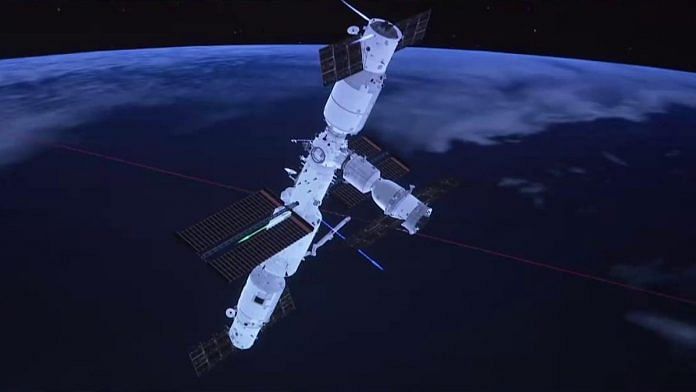Bengaluru: China has sent three astronauts on a six-month mission to finish assembly of its orbiting space station, Tiangong. The crew includes Liu Yang, who was the first Chinese woman to go into space in 2012, and fellow astronauts Chen Dong and Cai Xuzhe.
Their spaceflight, Shenzhou-14, reached the core module and living quarters of the space station, called Tianhe, at 9.42 am GMT Sunday. It docked at the Tiangong six hours after being launched from the Jiuquan Satellite Launch Center in the Gobi Desert.
The crew of taikonauts (derived from the Mandarin word ‘tàikōng’, meaning space) will spend six months on the space station, overseeing the assembly of two more laboratory modules — Wentian and Mengtian — to be launched separately later this year.
They will also conduct scientific experiments and perform educational outreach activities as well as spacewalks, according to Chinese space officials.
Construction of the space station began last year, and it’s planned for completion by the end of this year. It is expected to be the crown jewel of the China National Space Administration and its 30-year-old crewed space programme.
Also Read: Moon & Mars done, Jupiter & Uranus next on the list — China’s racing away in space too
Tianhe, Wentian and Mengtian
The Tiangong space station is currently being assembled in low Earth orbit, approximately 400 km above the planet’s surface, according to Chinese media reports.
It is China’s first permanent or long-term space station, built along the lines of the International Space Station, which is a multinational collaborative project, and the former Soviet Union’s Mir, which was decommissioned by the Russian government in 2000-01.
A modular station, the design and construction of the Tiangong — which means ‘heavenly palace’ — is based on its precursors, the Tiangong-1 and 2, which have both since burned up in the atmosphere.
The station design includes three main modules — Tianhe, Wentian and Mengtian.
The Tianhe core module includes habitable living quarters, a non-habitable service section, and a docking port. It was launched in April 2021 and makes up the central core of the station.
Once completed, the space station will be shaped like a T, with the two labs — Wentian and Mengtian — making up the two arms of the Tianhe core module.
The Wentian (meaning ‘Quest for the Heavens’) module will provide additional navigation and propulsion control, and also act as a backup to Tianhe. It will contain a pressurised environment for zero-gravity research.
This module is expected to launch on 23 July this year. Once near its destination, it will be docked to the station by the taikonauts using a large robotic arm. Its airlock will be used as the exit port for future extravehicular activity or spacewalks.
The Mengtian (‘Dreaming of Heavens’) module — which will also be docked the same way after launching in October this year — is another pressurised research module. Both modules will also be fitted with experiments on the outside, exposed to the harsh vacuum of space.
The Chinese space agency has been planning non-crewed missions with supplies (Tianzhou) to arrive ahead of crewed missions (Shenzhou). Two crews have previously already occupied the Tianhe module, and the next crew is slotted to arrive by the end of the year, after another supply mission and just before the current crew of three returns to earth.
Crews are typically made up of three members and overlap for a few days in the Tianhe, which can host six individuals.
China’s international space relations
China does not use the International Space Station (ISS) because the United States’s laws do not allow for cooperation with Beijing, reportedly due to human rights and national security concerns.
While Russia is an active participant in ISS and has been historically, it has indicated that it might withdraw from the ISS by 2025, owing to sanctions imposed by the US due to the invasion of Ukraine.
Meanwhile, US space agency NASA is pushing forth the ‘Artemis’ programme and the associated Artemis Accords — an international agreement between countries participating in the programme — with the goal of sending astronauts to the moon once again.
The accords are drafted by the US Department of State and aim to establish a cooperative framework for civil exploration and mining of astronomical objects.
Countries that do not participate in the Artemis programme can also be signatories to the accords and the principles of space exploration they lay out. Chinese state media have been critical of the accords, categorising them as a plan for a “space-based NATO”.
According to reports, India is considering “potential cooperation in Artemis and the Artemis Accords”.
(Edited by Gitanjali Das)
Also Read: Russia blows up own satellite in low Earth orbit, NASA says it put ISS astronauts in danger



